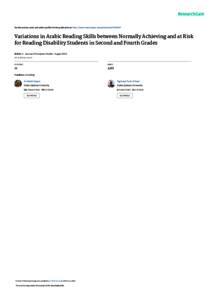Document
Variations in Arabic reading skills between normally achieving and at risk for reading disability students in second and fourth grades.
Identifier
DOI: 10.5539/res.v6n3p17
Contributors
Kazem, Ali., Author
Al-Said, Taghreed., Author
Al-Maamaryah, Watfa., Author
Al-Monzeryah, Raya., Author
Publisher
Canadian Center of Science and Education.
Gregorian
2014-08
Language
English
English abstract
The study investigated variations in Arabic reading skills between normally achieving students and students at risk for reading disability in second and fourth grades. Using a cross-sectional design the study tested the effect of gender, grade level, and student condition on the variation of Arabic reading skills. Participants were 381 Arabic speaking children from second and fourth grades. Participants included both normally achieving students and students who were referred to the Learning Disabilities Unit in elementary schools in Oman. Dependent measures of the study included letter sound identification (LSI), word decoding (WD), phonological awareness (PA) through blending and segmentation, word recognition (WR), reading comprehension (RC), and listening comprehension (LC) in Arabic. Multivariate analysis indicated that gender, grade level and student condition had an effect on variation of reading skills. Additionally, the interaction effect of grade level and student condition as well as the combination of the three independent variables showed similar effects. Significant reading skills varied according to gender, grade level and student condition in addition to the interaction effects. WD, LSI and LC were significant as a result of the interaction effects. The results are discussed in relation to the characteristics of the Arabic language orthography.
Member of
ISSN
1918-7173
Resource URL
Category
Journal articles

